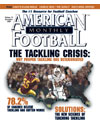AMERICAN FOOTBALL MONTHLY THE #1 RESOURCE FOR FOOTBALL COACHES
Article CategoriesAFM Magazine
|
Alternative Trainingby: Scott SinclairAsst Dir of Strength & Conditioning, University of Central Florida © More from this issue Every offseason coaches begin their workouts and conditioning drills in hopes of producing superior athletes for the football field. Many exercises are designed to produce faster, stronger, more explosive athletes and reduce the chance of injury. The list of exercises can be endless and many are very sports specific. The goal is to produce explosive, powerful, fast football players, not bodybuilders, Olympic lifters, or strongmen. At the University of Central Florida we use a variety of exercises to accomplish these goals. These exercises include the Olympic lifts such as the power clean and snatch. We also train with power lifts such as the bench press and squat. I believe the unique part of our training comes from the alternative training we perform. Through the use of non traditional equipment, such as ropes, tires, sl....The full article can only be seen by subscribers. Subscribe today!
|
|
|||||||
| HOME |
MAGAZINE |
SUBSCRIBE | ONLINE COLUMNISTS | COACHING VIDEOS |
Copyright 2025, AmericanFootballMonthly.com
All Rights Reserved





